Enterprise software architecture is the backbone of any modern organization’s IT infrastructure. The blueprint defines how all the different software components and systems within an organization work together to deliver the desired business outcomes. With the increasing complexity of modern software systems and the need for scalability, security, and flexibility, solid architecture has become more critical than ever. You need to monitor the performance of the software on which your essential business functions depend, as it could impact your revenue and profitability. Do you know that the ability of your enterprise software architecture pattern to scale and meet users’ demands in the future directly affects its performance? So, selecting the correct architecture pattern for your enterprise software can make the difference between building a future-ready application or just another addition to your existing IT infrastructure.
This blog post will explore some of the most used enterprise software architecture patterns, their benefits, and how they can help organizations build robust and scalable software systems.
What are the Enterprise Software Architecture Patterns?
Enterprise software architecture patterns are commonly used to solve common design problems in software architecture. These patterns have been proven and tested over time and have become standard ways to organize software systems to achieve specific goals such as scalability, security, maintainability, and flexibility. These patterns help software architects and developers to design and build complex systems that can meet the demands of modern enterprise environments.
Importance of Software Architecture Patterns
By selecting the right architecture pattern, you can ensure the success of your software development and avoid a negative impact on your business. The following factors reveal the importance of software architecture patterns in the development process:
- Application Characteristics: The architecture pattern defines a software’s fundamental elements and actions. So, depending on the business needs, risks, limitations and more you must select the architecture pattern that best suits your organization. For example, a complex microservices architecture pattern is not needed to build a banking application that needs to fetch requests.
- Quality & Efficiency: The architecture pattern that matches the quality attributes of your software helps avoid quality issues later and efficiently maintains its performance.
- Agility: Any software development involves many modifications and interactions at all stages, even after deployment. By selecting the architecture pattern, you can bring skill to the development process and carry out improvements smoothly.
- Problem-solving: Software architecture patterns provide complete visibility into the functioning of every component within the application and how the custom-built IT solution will function. So, when errors or complexities arise, studying the architectural pattern and identifying the solution to such problems is more accessible.
- Productivity: Architecture pattern provides standardized principles to be applied for your software development project concerning the framework, programming language, and application. So, by having an architecture pattern in place, your project scope gets clear, and you can quickly understand its completion and quality status during any development stage.
Types of Software Architecture Patterns
Here are some of the most used and popular software architecture patterns:
Layered Architecture Pattern
Layered Architecture, also called the n-tiered pattern, has interconnected horizontal layers that are not interdependent. Each layer has a specific role in the application, depending on the nature of its underlying code. While it is possible to have any number of layers, typically, a layered architecture pattern has four layers:
- Presentation Layer carries out user interface logic and browser communication,
- Business Layer is in charge of executing specified business rules for a request,
- Persistence Layer handles the persistence of data and functions, and
- Database Layer provides data storage and retrieval ability to the application.
This enterprise software architecture pattern has a tiered method of how the layers function like the logical layer offers services to another layer. The image below shows that the bottom database layer delivers services to the subsequent upper layers.
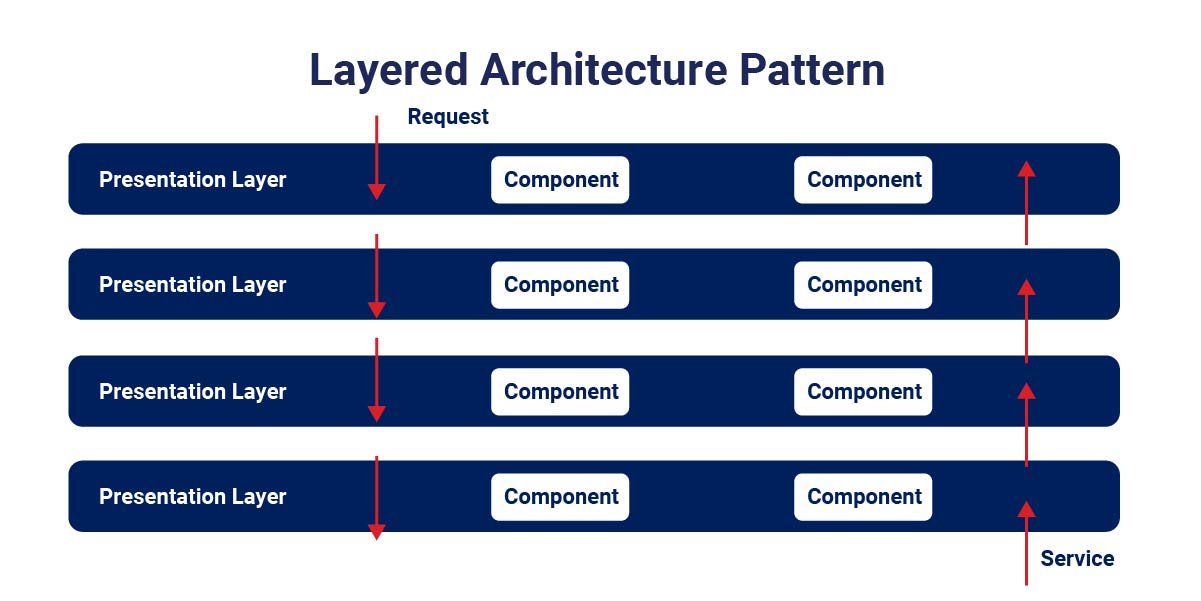
Benefits of Layered Architecture Pattern:
- Easy to maintain due to separate maintenance ability
- Smooth testing due to independent layers
- Convenient for assigning distinct roles
- Effortless layers’ update
Shortcomings of Layered Architecture Pattern:
- High complexity and issues if the source code is unorganized and the roles are unclear.
- If the developer skips previous layers to create tight coupling, the software could land into a logical mess creating complex interdependencies.
- The software could need complete redeployment even to make essential modifications.
- The independence or isolation of layers makes it difficult to understand the architecture without understanding every module in the application.
Use Cases of Layered Architecture Pattern:
The layered architecture pattern is ideal when:
- The application needs to be built quickly
- The enterprise needs a traditional IT infrastructure and processes
- The architecture should be able to handle maintenance and issue resolution separately.
- Your team of developers is not appropriately skilled and experienced.
- You need strict testability standards.
- You want to build general desktop applications or e-commerce web applications.
Event-driven Architecture Pattern
Being agile and high-performing, this pattern enables modules to work when events occur. It comprises single-purpose, decoupled components that identify, process, and respond to specific events asynchronously. This pattern for architecting enterprise applications arranges the behavior around the events’ production, detection, and consumption and the responses they receive. It has two topologies- mediator and broker. The broker topology is used to link events collectively without a central mediator. While in contrast, the mediator topology is used for orchestrating multiple operations within the event bus with the help of a significant mediator.
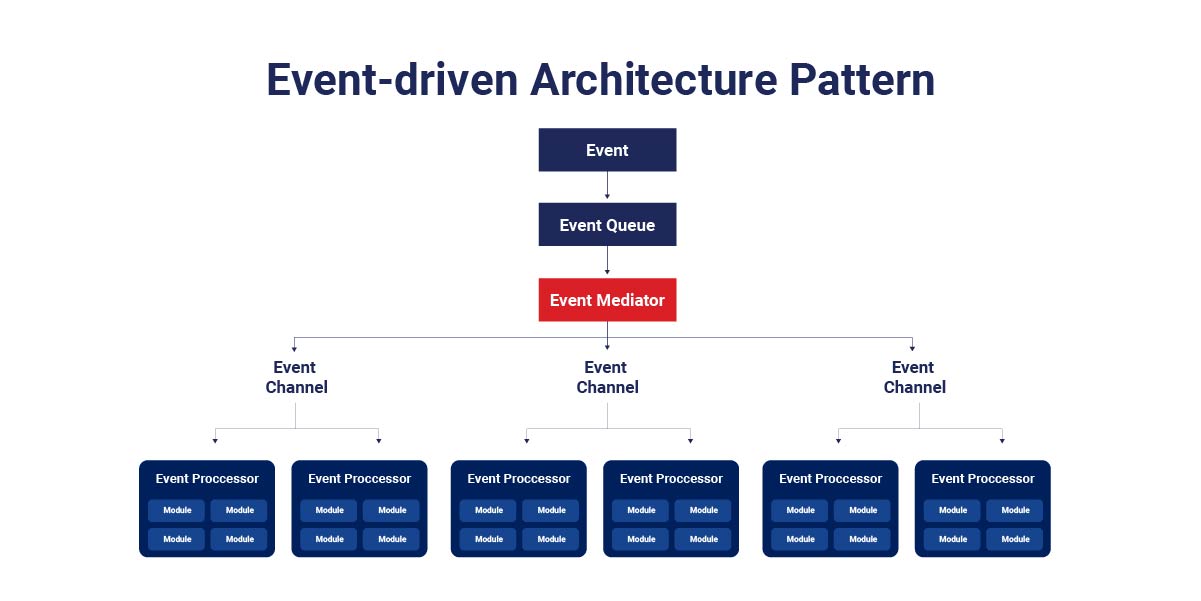
Benefits of Event-driven Architecture Pattern:
- Adaptable to real-time changes
- Provide real-time updates in the application with asymmetric data flow
- High response time leads to better business outcomes and scalability
- Testing of independent, individual modules can be carried out smoothly
Shortcomings of Event-driven Architecture Pattern:
Error handling is complex when several modules handle a particular event.
Developing a system-wide data structure is not possible if events have different needs. Independent, decoupled modules make it challenging to maintain a transaction-based mechanism.
Use Cases of Event-driven Architecture Pattern:
It is suited for:
- Asynchronous software systems with asymmetric data flow
- Applications that tend to scale
- Applications having individual data blocks that interact with some modules only
- Apps with highly responsive and interactive user interfaces
- Applications scaling on-demand and leveraging instant data communication
- Applications that require seamless data communication
- IoT devices that need to exchange data in real-time
- Live streaming applications
Microservices Architecture Pattern
This enterprise software architecture pattern consists of independent components deployed as separate units via a streamlined delivery pipeline. Their codebase can be written and maintained by a small developers’ team. Different teams can develop, deploy, and test other microservices separately. Each microservice must execute the business logic associated with it. Also, they are accessible through a remote access protocol, and it is possible to release software versions without waiting to develop the entire IT system.
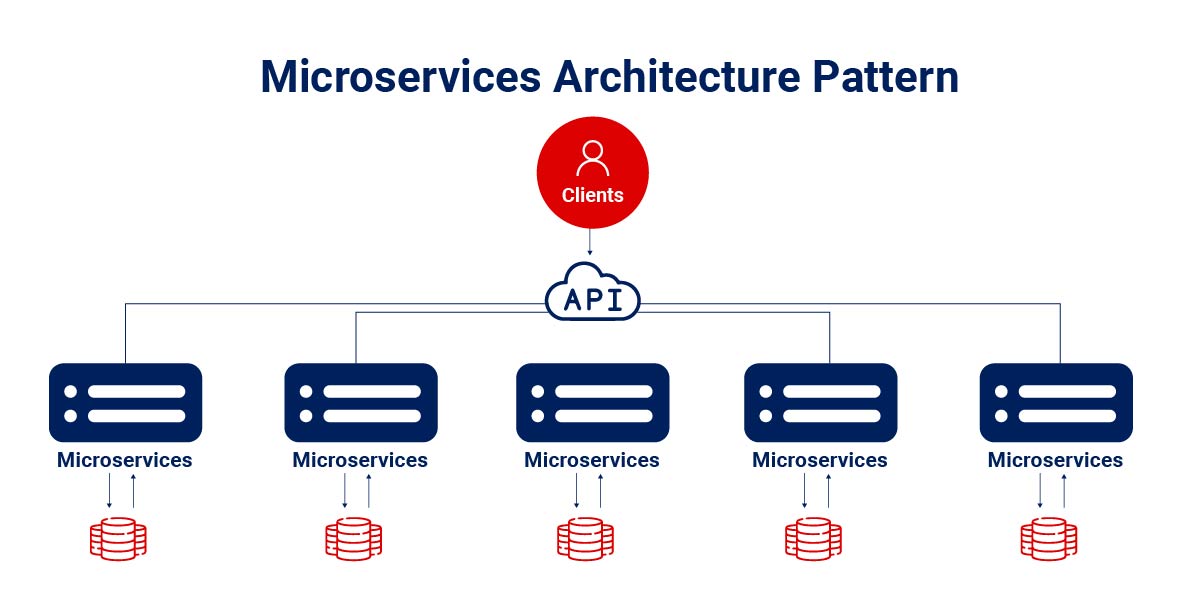
Benefits of Microservices Architecture Pattern:
- Provides decoupling of a high degree to the application
- Can build applications with high fault tolerance as the failure of microservices will not halt the functioning of the entire software
- The ability to update each component with the latest tech stack and different programming languages enhances application scalability.
- Possible to integrate different services into the application
Shortcomings of Microservices Architecture Pattern:
- Interlinking the components and managing them individually is difficult
- It is challenging to maintain data integrity and security
- It isn’t easy to design the right level of granularity
- All tasks can’t be split into independent units
- Spreading tasks across different microservices affects performance
Use Cases of Microservices Architecture Pattern:
- Upgrading legacy applications
- Software requiring fast-growing data systems
- Monolithic applications and service-oriented architectures
- Web apps needing rapid development
- Websites with small components,
- Data centers with well-defined boundaries,
- Global remote teams
Space-Based Architecture Pattern
The basis of space-based architecture patterns is tuple space (distributed shared memory). It consists of a processing unit and a virtualized middleware. The processing unit contains application components, like backend logic and web-based features. To avoid functional collapse, this architecture allows smaller web apps to decouple and deploy in a single processing unit, whereas larger apps can split app functionality into multiple processing units. The virtualized middleware contains elements controlling different data synchronization and request handling aspects (custom-written or third-party integrations).
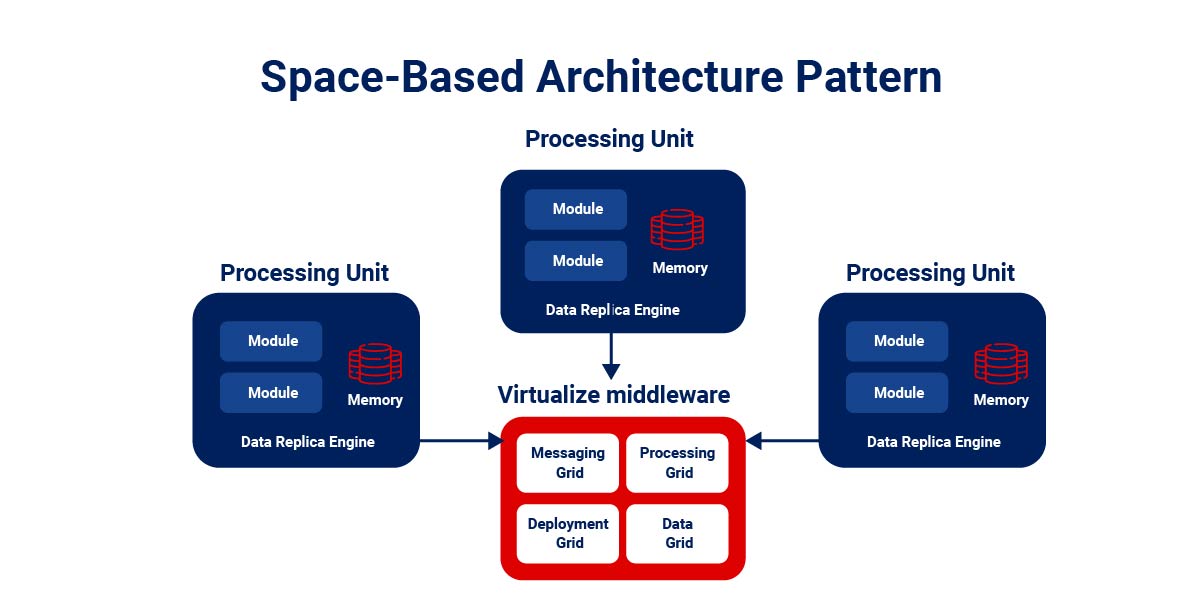
Benefits of Space-Based Architecture Pattern:
- Has the ability to overcome high-load issues
- Can address concurrency and scalability issues
Shortcomings of Space-Based Architecture Pattern:
- Caching data for speed without disturbing multiple copies is highly challenging and complex
- RAM databases do not enjoy transactional support
- Testing the entire system is difficult due to the requirement of generating enough load
Use Cases of Space-Based Architecture Pattern:
- To build apps that can address scalability and concurrency problems
- For applications having unpredictable and variable concurrent user volumes and the constant load of requests
- For apps containing low-value data, which, if lost occasionally, doesn’t lead to severe consequences
Master-Slave Architecture Pattern
The master-slave enterprise software architecture pattern includes a master database and many slave components. It is suitable for applications receiving many requests at the same time. It can be visualized as a master distributing tasks among all the slave components and the ones executing them simultaneously. The master database controls how the slave components handle requests and communication.
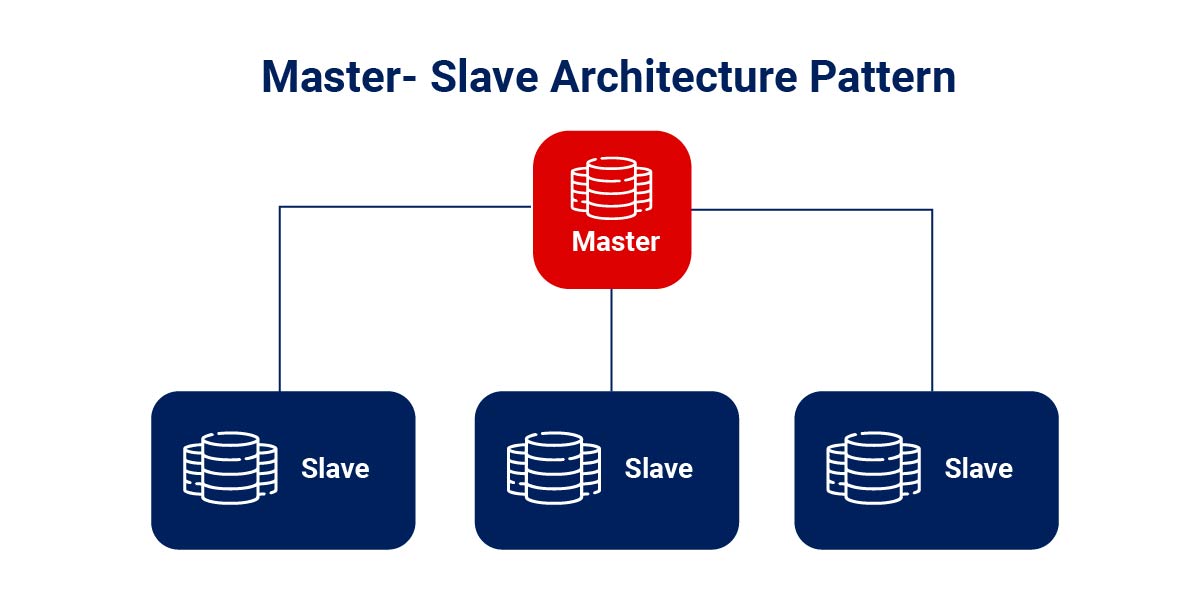
Benefits of Master-Slave Architecture Pattern:
- Its multi-loop functionality provides better control over the software’s time management
- Ability to handle heavy multitasking
- Allows the application to split into smaller modules to perform similar user requests at the same time and give results
- It can help apps process raw data stored in different servers over a distributed network
- Increases responsiveness of web browsers following multithreading
Shortcomings of Master-Slave Architecture Pattern:
- As slave components have no backup, failure of the master database leads to data loss
- Heavy dependencies within the software could lead to the failure of slave components
- The isolated nature of the slave components could increase overhead costs
Use Cases of Master-Slave Architecture Pattern:
- Creating Operating Systems needing architecture that is compatible with multiprocessors
- Leading-edge applications that require more extensive services to be split into smaller components
- Websites or web apps using multithreading
Microkernel Architecture Pattern
It comprises two components: a core system that works on minimal functionality & keeps the software operational, along with plug-ins as independent components with specialized processing capabilities. While the core system is the software’s business logic, plug-ins have custom code for special rules, complex and conditional processes, exceptional cases & more to deliver enhanced business capabilities.
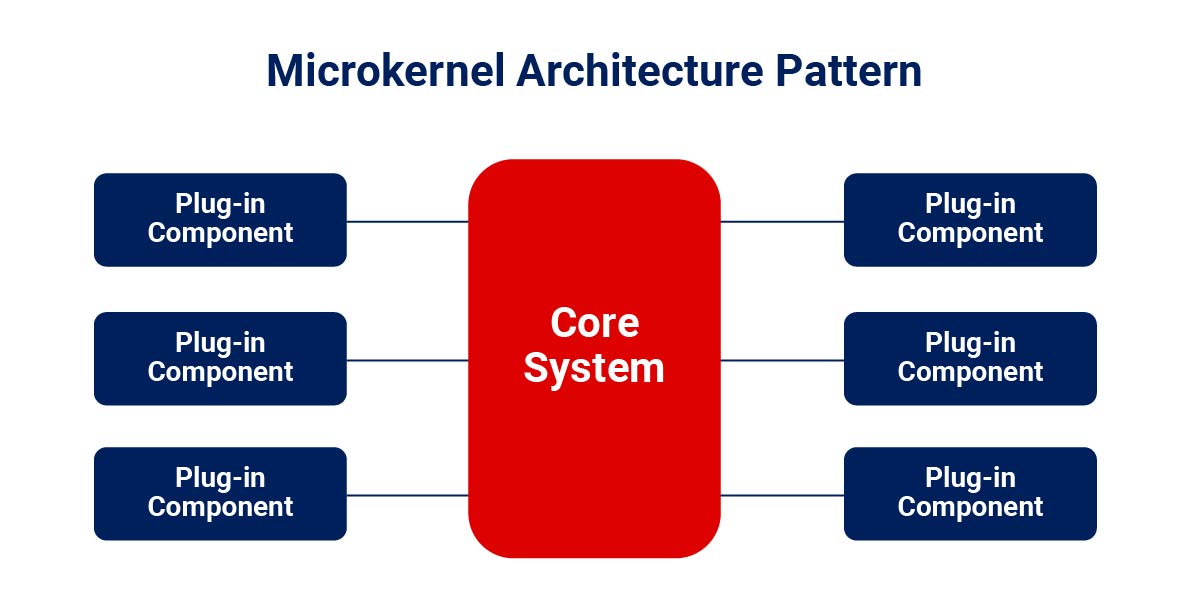
Benefits of Microkernel Architecture Pattern:
- Highly flexible
- Capable of reacting to changes in near real-time
- Requires fewer developmental updates over time
- Ability to test plug-in prototypes in isolation and measure performance without disturbing the architecture core
Shortcomings of Microkernel Architecture Pattern:
- It could face downtime issues during deployment, which can be resolved by dynamically adding plug-ins to the core
- It has a fixed scaling scope
- Difficult to execute as many plug-ins are compatible with the core
Use Cases of Microkernel Architecture Pattern:
It is best suited for:
- Third-party apps providing software packages in the form of downloadable plug-ins
- Creating large-scale, complex applications, such as software for processing insurance claims
- Internet browsers
- Maintaining high-performance applications
- Workflow applications
Client-Server Architecture Pattern
This is a distributed application structure consisting of a client and a server as its two essential components that may or may not be under the same network. The client-server architecture pattern helps the client and the server to communicate, where the client is the producer and the server is the consumer. The client raises requests, and the server responds to them. The server can support multiple clients, and the client can support numerous servers offering high flexibility to the software.
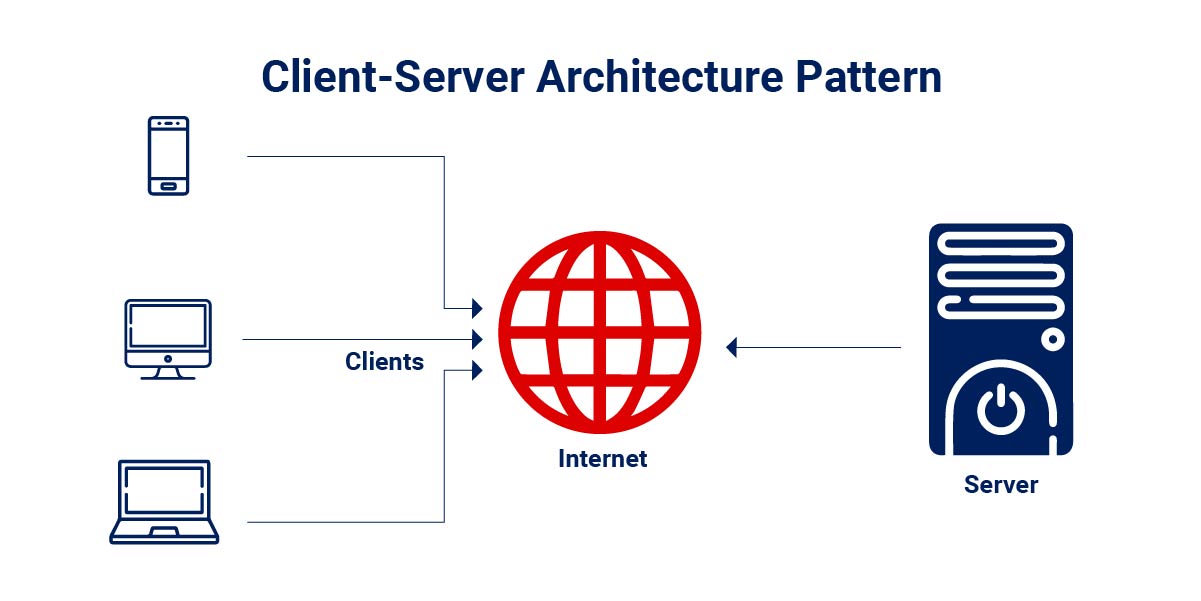
Benefits of Client-Server Architecture Pattern:
- Its functionality is highly flexible
- It provides a good user experience
- It can very well protect the data.
- It helps track and find files required.
- It is easy to relocate and update the server without disturbing the client.
Shortcomings of Client-Server Architecture Pattern:
- A single point of failure could impact the server.
- It isn’t easy to maintain the server.
- An incompatible server could lead to slow performance.
Use Cases of Client-Server Architecture Pattern:
- Applications like gaming apps, online banking services, network printing, emails, the World Wide Web, file-sharing applications, and more
- Software focusing on real-time services. For example, telecommunication apps use a distributed app structure.
- Apps that offer multiple services to many distributed clients and need controlled access.
- Applications that need to distribute centralized resources and services to multiple servers
Software Architecture Patterns Vs. Design Patterns
While many people mistakenly use the terms software architecture patterns and design patterns interchangeably, there is a thin line between them. An architecture pattern is used to create business logic, database logic, and more, whereas a design pattern is used to implement them. Here’s a comparative analysis between enterprise software architecture patterns and design patterns on different parameters.
Definition:
- Software architecture patterns provide a clear idea of the fundamental structures within software systems.
- Design patterns provide specifications for the implementation of software.
Role:
- Architecture patterns convert software characteristics into structures at a high level.
- Design patterns support coding by describing all units within the software.
Examples:
- Application architecture patterns like event-driven, serverless, and microservice
- Application design patterns like behavioral, structural, and creational
Level:
- Architecture patterns are large-level tools concerned with a system’s large-scale mechanism, property, and components.
- Design patterns are small-level tools concerned with building smaller subsystems and their behavior, relationships, structures & more
Addressing Issues:
- Architecture patterns address issues concerning software functionality, scalability, interfaces, security, and more
- Design patterns overcome problems involving software development.
Comparison Between Enterprise Software Architecture Patterns
Now that we know their types let’s compare different enterprise software architecture patterns on varied parameters like agility, ease of deployment, testability, performance, scalability, and ease of development.Layered Architecture Pattern
- Agility: Low
- Deployment Ease: Low
- Testability: High
- Performance: Low
- Scalability: Low
- Development Ease: High
Event-based Architecture Pattern
- Agility: High
- Deployment Ease: High
- Testability: Low
- Performance: High
- Scalability: High
- Development Ease: Low
Microservices Architecture Pattern
- Agility: High
- Deployment Ease: High
- Testability: High
- Performance: Low
- Scalability: High
- Development Ease: High
Space-based Architecture Pattern
- Agility: High
- Deployment Ease: High
- Testability: Low
- Performance: High
- Scalability: High
- Development Ease: Low
Master-Slave Architecture Pattern
- Agility: Low
- Deployment Ease: High
- Testability: High
- Performance: High
- Scalability: High
- Development Ease: High
Microkernel Architecture Pattern
- Agility: High
- Deployment Ease: High
- Testability: High
- Performance: High
- Scalability: Low
- Development Ease: Low
Client-Server Architecture Pattern
- Agility: High
- Deployment Ease: High
- Testability: High
- Performance: Low
- Scalability: Low
- Development Ease: High
How to Choose the Right Enterprise Software Architecture Pattern?
No one-size-fits-all architecture pattern exists, even if most can adapt to multiple use cases. So, you must identify the one that best suits your business needs for architecting enterprise applications by considering several elements:
- The functionality required: If your potential software’s functionality is essential, a monolithic or service-oriented architecture will work for you. However, you would need serverless or microservices systems if there are high complexities.
- Flexibility and productivity needs: If your flexibility and productivity needs are high, it would be advisable to use components of web application architecture that could allocate request handling to user endpoints. You could also develop microservices-based apps.
- Application storage requirements: You have many choices depending on your storage needs. For instance, service-oriented architecture is best suited if your software operates behind industry firewalls. Going for cloud-native techs like microservices or containers would make more sense. Though you can decide on partial or complete deployment on Cloud, using frameworks of system operators like AWS (Amazon Web Services) and Microsoft Azure will be good for you.
- Scalability: If you plan to build an application for a specific purpose and know it will not require frequent modifications or updates, you can select a monolithic pattern. Suppose your potential software needs to scale rapidly with considerable improvements, it would be wise to go for a services-based pattern.
- Skill and experience level of your development team: For a team with essential skill sets, it would be better to start with building monolithic or service-oriented applications. Building software utilizing microservices, serverless, and more requires higher experience and skills.
Selecting the enterprise application architecture is crucial in developing an IT infrastructure that is responsive to business demands and reflects the organization’s most valuable traits. At Rishabh Software, we have experienced engineers with excellent knowledge in adopting the best architectural approaches for software projects. As an enterprise software development services company, we have helped businesses adopt the architecture for their software application.
While new architectural styles are emerging, most businesses can benefit from adopting a specific enterprise application architecture. The architectural patterns discussed here are all valid options, like building a house in Gothic or Windsor styles. However, it is the responsibility of the technical architect & team to ensure that the chosen design is appropriate for their environment.
Concluding Thoughts
Enterprise software architecture patterns play a critical role in designing and building complex software systems that meet the evolving needs of modern businesses. Now that you know the importance and types of enterprise software architecture patterns, you can select the most suitable design for your business. And by leveraging these patterns, architects and developers can create flexible, scalable, and robust solutions that adapt to changing business requirements and technical environments.
While there are numerous patterns to choose from, selecting the ones that best suit your specific needs and objectives is essential. Ultimately, by adopting a thoughtful approach to software architecture design and using proven patterns, organizations can improve their software solutions’ quality, efficiency, and effectiveness and better position themselves for success in the digital era. It would help to partner with an experienced software development firm to avoid common pitfalls and ensure the smooth delivery of your intended software.











 30 Min
30 Min


